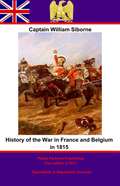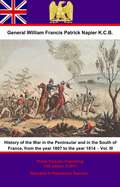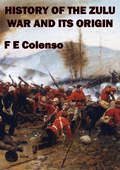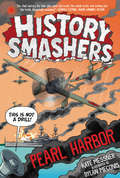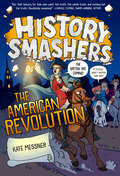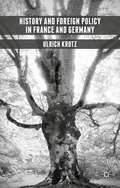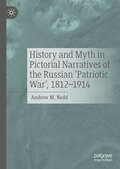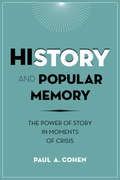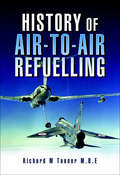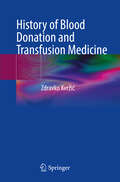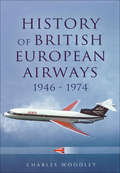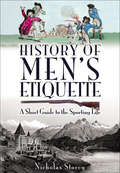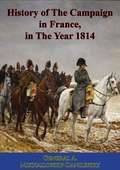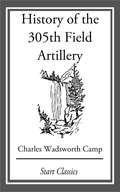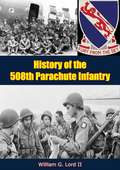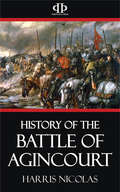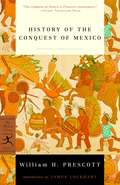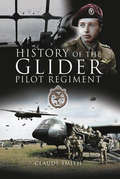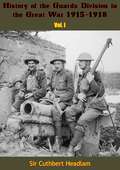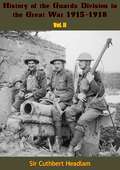- Table View
- List View
History Of The Third Infantry Division In World War II, Vol. III (History Of The Third Infantry Division In World War II #3)
by Lt. Donald G. TaggartFew units in the U.S. Army can boast as proud a unit history as the Third Infantry Division; it fought on all of the Europe and North African fronts that American soldiers were engaged against the Axis forces during World War II. The 3rd Infantry Division saw combat in North Africa, Sicily, Italy, France, Germany and Austria for 531 consecutive days. In this official division history written by the officers who served with the unit at the time serves as a fascinating memorial and a detailed history of the "Marne Division" during World War II.The 3rd Inf. Division made landfall in Fedala on the 8th November 1942 as part of Operation Torch during the Allied invasion of North Africa and was engaged in heavy fighting before the German and Italian troops were finally levered out of the continent. The division was back in the thick of the fighting in Sicily under the command of such famous leaders as Generals Lucien Truscott, Omar Bradley and George S. Patton. As part of General Mark Clark's U.S. Fifth army it engaged in some of the bloodiest engagements of the Italian campaign at Salerno beaches, Volturno river, Monte Cassino and Anzio. Under their old division commander General Truscott they formed part of the force that landed in Southern France and battled into the heart of Germany before the eventual capitulation of the Nazi High command in 1945.Richly illustrated with maps and pictures throughout.
History Of The War In France And Belgium In 1815. 3rd Edition
by Pickle Partners Publishing Captain William SiborneThis ebook is purpose built and is proof-read and re-type set from the original to provide an outstanding experience of reflowing text for an ebook reader. When Captain Siborne died in 1849, it is unlikely that he was aware of the enduring historical legacy that he was to leave behind. His History of the War in France and Belgium in 1815 has become the most well known English history of the famous campaign and despite being written over 150 years ago is still in print, still eminently readable and remarkably accurate. The book was the result of his life's work and passionate dedication to the "Waterloo Model" which depicts a stage of the battle in tremendous detail. The accuracy of the book is accounted for by four tremendously important points; Firstly, Siborne was engaged by the British military establishment to produce a model of the battle of Waterloo, which he did with scrupulous accuracy including painstaking research on the battle ground and environs including surveys of the ground. Secondly, Siborne was a noted topographical engineer who wrote a number of treatises and one of the standard works of the time enabling his appreciation of the battle to be precise and avoid fault of many histories written merely from maps (some produced years afterward)of the area. Thirdly, he undertook what was a the time a ground-breaking "questionnaire" of the surviving officers of the British, King's German Legion, Hanoverian units involved, to piece together the events of the day. These letters were published in part by Siborne's son much later. Fourthly he expanded his search for eye-witness testimony to both the Prussian and French army staffs, and although rebuffed by the French, who were understandably tender about the loss of the battle and their Emperor with it, his enquiries were fruitful amongst the Prussian command who supplied a priceless counterbalance to the sometimes jingoistic British accounts. Siborne and his works were ahead of their time, and his search for an accurate representation of the battle won him few friends at Horse Guards. Funding was difficult to obtain from the British establishment and Siborne's attempts at self-funding the model which was his life's work were unsuccessful, Siborne died a broken man. He left behind the "Waterloo Model" and a larger scale model which are housed at the Royal Army Museum in London and this excellent book. We chose the third edition as it includes the impassioned defence of his work against the plagiarism of Rev R Gleig's "Story of Waterloo" and a number of notable changes from the first and second editions prompted by further eye-witness testimony gathered by Siborne. Text taken, whole and complete, from the 1848 third edition, published in London by T and W Boone Original - 667 pages. Author - Captain William Siborne (15 October 1797-9 January 1849) Linked TOC. - in keeping with the format of the times that the book was published the table of contents includes the summary notes of each chapter.
History Of The War In The Peninsular And In The South Of France, From The Year 1807 To The Year 1814 – Vol. III (History Of The War In The Peninsular And In The South Of France, From The Year 1807 To The Year 1814 #3)
by General William Francis Patrick Napier K.C.B.A masterful, epic account of the Spanish Ulcer that drained Napoleon's resources and played a pivotal role in the end of his domination of Europe.The author served with distinction in the actions of the Light Division, such as the epic march to Talavera, the battles of Fuentes d’Oñoro, Salamanca, Nivelle, Orthes and Toulouse. He left the service a General and Knight Commander of the Order of Bath. Napier’s History would rank as the most important history to be written by an actual participant, and was as controversial with his countrymen as amoung his contemporaries on the Continent. In this third volume (Mid-1810 to Sept 1811), covers the third French invasion of Portugal under Massena, although he outnumbers his British and Portuguese opponents is beset by problems, not the least of which are his sub-ordinates who are loath to obey him. As he drives into Portugal he is given a bloody nose at the battle of Busaco, and a horrible surprise at the lines of Torres Vedras, which are impregnable. Forced to retire through devastated countryside, culminating in the battle of Fuentes D’Oñoro as he tries to relieve the garrison of Almeida, which had been left behind. All in all the French would never set foot in force again in Portugal and Wellington’s strategies would be vindicated.However Napier put these events in their proper context, the seemingly inexorable march to an Allied victory is far from the reality of the situation; an expedition to Fuengirola under Lord Blayney is routed, British expeditions along the Eastern coast of Spain are foiled and in the case of Taragona, it falls in sight of the force sent to aid it. The Regency of Portugal and the court in Brazil intrigue and cause trouble and strife, the Spanish troops start to rack up some small scale victories but are handled and led badly in most cases. The detached corps of Marshal Beresford fights the bloody battle Albuera, Napier is none too kind in his criticisms of his actions.
History Of The Zulu War And Its Origin (Cambridge Library Collection - Naval And Military History Ser.)
by Frances Colenso Edward DurnfordThe Zulu War-by possibly its most authentic historians.Most written histories intend to be accurate, but they often suffer from the bias of perspective, and whilst this history of the Anglo-Zulu War is no exception, it is exceptional in that it is decidedly not a view of the conflict from an Imperial British standpoint. Francis Colenso was the daughter of Bishop Colenso, whose Bishopric included Zululand at the time of the war. She knew the Zulu nation well, had an affection for it and in company with her father was an ardent advocate in its cause. She was well aware of the many shameful calumnies perpetrated against it by the British including the bringing about of the war of 1879 itself. This history, written by an author who was on the spot, was originally published very shortly after the events themselves took place. It provides a very different view, far removed from a story of Imperial glory or folly. Ultimately the traditional Zulu way of life was destroyed by the war and the injustice and tragedy of that is painfully elaborated in these pages. 'Fanny' Colenso had a close personal relationship with Colonel Anthony Durnford, who fell at Isandlwana and who became one of Lord Chelmsford's scapegoats for the disaster. For the military aspects of her history she called upon the assistance of Durnford's brother, Edward-also a soldier-to provide vital expertise, credibility, accuracy and authority. This is the first and possibly the most important history of the Zulu War and the events that bought it about and is an essential component of any library of the history of South Africa.
History Smashers: Pearl Harbor (History Smashers)
by Kate MessnerMyths! Lies! Secrets! Uncover the hidden truth behind the infamous Pearl Harbor attack with beloved educator/author Kate Messner. The fun mix of sidebars, illustrations, photos, and graphic panels make this perfect for fans of I Survived! and Nathan Hale's Hazardous Tales.On December 7, 1941, the Japanese launched a completely unpredictable attack on the U.S. Navy base at Pearl Harbor, Hawaii. Right? Well, that's not quite the real deal. Some military experts had suggested that Pearl Harbor was a likely target. There were other warning signs, too, but nobody paid much attention. From the first wave of the Japanese bombers to the United States' internment of thousands of Japanese Americans, acclaimed author Kate Messner smashes history by exploring the little-known truths behind the story of Pearl Harbor and its aftermath.Don't miss History Smashers: The Mayflower and Women's Right to Vote
History Smashers: The American Revolution (History Smashers)
by Kate MessnerMyths! Lies! Secrets! Uncover the hidden truth behind the Revolutionary War with beloved educator/author Kate Messner. The fun mix of sidebars, illustrations, photos, and graphic panels make this perfect for fans of I Survived! and Nathan Hale's Hazardous Tales.On April 18, 1775, Paul Revere rode through Lexington and Concord, Massachusetts, shouting, "The British are coming!" to start the American Revolution.RIGHT?WRONG! Paul Revere made it to Lexington, but before he could complete his mission, he was captured!The truth is, dozens of Patriots rode around warning people about the Redcoats' plans that night. It was actually a man named Samuel Prescott who succeeded, alerting townspeople in Lexington and then moving on to Concord. But the Revolutionary War didn't officially start for more than a year after Prescott's ride. No joke.Discover the nonfiction series that smashes everything you thought you knew about history. Don't miss History Smashers: The Mayflower, Women's Right to Vote, Pearl Harbor, and Titanic.
History Wars: The Enola Gay and Other Battles for the American Past
by Edward T. Linenthal Tom EngelhardtCollection of historiographic essays
History and Foreign Policy in France and Germany
by Ulrich KrotzWhy do states similar in size, resources and capabilities significantly differ in their basic orientations and actions across major domains in foreign policy, security and defense? This book addresses this important question by analyzing the major differences between the foreign policies of France and Germany over extended periods of time.
History and Myth in Pictorial Narratives of the Russian 'Patriotic War', 1812-1914
by Andrew M. NeddThis book reveals that the visual narrative of the events of the Russian campaign of 1812 was inextricably linked to Russia's search for national identity and helped to form competing definitions of 'Russianness'. No pre-revolutionary military event was more celebrated in Russian literature and art than the ‘Patriotic War of 1812’, during which Napoleon advanced his Grand Armée into Russia, only to retreat months later in defeat as his army faced starvation and capture during the brutal winter. The works of art that retold the story of 1812 extolled virtues that were represented as inherently Russian: courage, resourcefulness, and unity. Furthermore, these values were increasingly contrasted with those of the foreign invader from the west. While the emphasis is largely on academic painting, this book also explores popular media and memorialization in order to reveal the role that images played in the process of constructing identities in nineteenth-century Russia.
History and Popular Memory: The Power of Story in Moments of Crisis
by Paul CohenWhen people experience a traumatic event, such as war or the threat of annihilation, they often turn to history for stories that promise a positive outcome to their suffering. During World War II, the French took comfort in the story of Joan of Arc and her heroic efforts to rid France of foreign occupation. To bring the Joan narrative more into line with current circumstances, however, popular retellings modified the original story so that what people believed took place in the past was often quite different from what actually occurred.Paul A. Cohen identifies this interplay between story and history as a worldwide phenomenon, found in countries of radically different cultural, religious, and social character. He focuses here on Serbia, Israel, China, France, the Soviet Union, and Great Britain, all of which experienced severe crises in the twentieth century and, in response, appropriated age-old historical narratives that resonated with what was happening in the present to serve a unifying, restorative purpose. A central theme in the book is the distinction between popular memory and history. Although vitally important to historians, this distinction is routinely blurred in people's minds, and the historian's truth often cannot compete with the power of a compelling story from the past, even when it has been seriously distorted by myth or political manipulation. Cohen concludes by suggesting that the patterns of interaction he probes, given their near universality, may well be rooted in certain human propensities that transcend cultural difference.
History and Psychoanalysis in the Columbus Centre: The Meaning of Evil (Routledge Studies in Modern History)
by Danae KarydakiThis book draws on a range of key archives and oral testimonies to provide the first systematic and historical study of the origins, context, development, frustrations, inner contradictions, and legacies of the Columbus Centre. The Columbus Centre, a remarkable though largely forgotten research institute, was established at the University of Sussex in 1966, triggered by claims of a dearth of academic research about Nazism and the Holocaust. Its basic stated aim was to bring together psychoanalysis and history for a scholarly investigation of discrimination, mass violence, and the preconditions of genocide in the past and the present. The Nazi crimes were studied along with other instances of prejudice and mass violence, such as sixteenth- and seventeenth-century witch-hunts, South African apartheid, the persecution of the Roma people, and race relations in the United States and modern-day Britain. The book seeks to place the Columbus Centre in the historiography of mass violence by analysing the Centre’s works through four historiographical prisms or power relations in which they were produced: psychoanalysis, class, race, and gender. This interdisciplinary volume is a valuable text for scholars and students of historiography, psychoanalysis, genocide and violence, and postwar Europe, and for professionals within the field of psychology.
History and Strategy (Studies in Intellectual History and the History of Philosophy #1)
by Marc TrachtenbergThis work is a powerful demonstration of how historical analysis can be brought to bear on the study of strategic issues, and, conversely, how strategic thinking can help drive historical research. Based largely on newly released American archives, History and Strategy focuses on the twenty years following World War II. By bridging the sizable gap between the intellectual world of historians and that of strategists and political scientists, the essays here present a fresh and unified view of how to explore international politics in the nuclear era. The book begins with an overview of strategic thought in America from 1952 through 1966 and ends with a discussion of "making sense" of the nuclear age. Trachtenberg reevaluates the immediate causes of World War I, studies the impact of the shifting nuclear balance on American strategy in the early 1950s, examines the relationship between the nuclearization of NATO and U.S.-West European relations, and looks at the Berlin and the Cuban crises. He shows throughout that there are startling discoveries to be made about events that seem to have been thoroughly investigated.
History for the IB Diploma: Causes, Practices and Effects of Wars
by Mike WellsAn exciting new series that covers the five Paper 2 topics of the IB 20th Century World History syllabus. This coursebook covers Paper 2, Topic 1, Causes, practices and effects of wars, in the 20th Century World History syllabus for the IB History programme. It is divided into thematic sections, following the IB syllabus structure and is written in clear, accessible English. It covers the following areas for detailed study: First World War (1914-18); Second World War (1939-45); Asia and Oceania: Chinese Civil War (1927-37 and 1946-9); and Europe and Middle East: Spanish Civil War (1936-9). Tailored to the requirements and assessment objectives of the IB syllabus, it allows students to make comparisons between different regions and time periods.
History of Air-to-Air Refuelling
by Richard M. TannerThis is a unique account of the development and operational use of air-to-air flight refuelling since its early beginnings in the USA and the UK to the equipment that is in use today. The author draws upon his life-long career as senior design engineer with the successful British company In-Flight Refuelling who were responsible for the development of the hose and drogue technique now preferred by many of the world's air forces. The story begins in the early 1920s when the art of air refuelling was part of the Barn Storming record-breaking attempts that were popular in the USA. It continues into the late thirties when successful experiments were made. Amazingly, the Royal Air Force were not interested in pursuing this great technical advantage during World War II and it was the USAAF who requested the British invention to experiment with on their B–17s and B-24s. The Korean War saw extended use of operational air-to-air refuelling for the first time and now the 'tanker fleet' is an essential unit in major air-forces around the world.
History of Blood Donation and Transfusion Medicine
by Zdravko KvržićThis book offers a global overview of the history of blood donation using evidence-based research to provide accurate information on the beginnings of blood donation and transfusion medicine, developed as the result of numerous trials and successes throughout history. It leads the reader step-by-step through time, to discover how people perceived blood, and how they managed to develop new ways of treating various unfortunate conditions that shattered a person’s healthy life. This book also presents new technical discoveries that have advanced through the present day and explains how, in cases of deadly diseases, safety procedures for blood examination have been made mandatory. The conditions that led to the contamination of thousands of patients by HIV and hepatitis C around the world are explained, and the debate between voluntary and paid systems is covered as well. This book is a unique resource beneficial for everyday practice, as it encourages the reader to develop advanced practices for better and safer work with blood donors and in transfusion medicine; It gives a sense of humanitarian devotion to the deed of giving a part of yourself to save others’ lives in danger because of trauma, disease, etc., and it shares different stories of blood donors, to help patients get over their fear of donating blood. It is useful for nurses, doctors, students, blood donors, historians, and other experts!
History of British European Airways, 1946–1972: 1946 - 1972
by Charles WoodleyBEA was formed in 1946 and took over most UK domestic and European routes under the British government's nationalisation policy. It began operations with a fleet of outdated and hopelessly uneconomic passenger aircraft that were derivatives of wartime types such as the DC-3, Avro Viking and Rapide. By the end of 1955 the airline had re-equipped with more modern types such as the jet-prop Viscount and moved into a profit for the first time. From 1960 onwards the airline introduced larger jets such as the Comet, Trident and BAC 1-11. BEA merged with the British Overseas Airways Corporation in 1974 to form British Airways.This book looks at BEA's predecessors, its formation and early operation from Croydon and Northolt and the move to the newly-opened London Heathrow. The evolving structure is explained with chapters covering engineering bases, terminals, European and domestic services, cargo services and helicopter operations. The aircraft flown are all described in detail and the book includes anecdotes from former crew and ground-staff, a full fleet list and is highly illustrated throughout.
History of Men's Etiquette: A Short Guide to the Sporting Life
by Nicholas StoreyThis is Nicholas Storeys third book in the series, following History of Mens Fashion: What The Well Dressed Man Is Wearing (2008), and History of Mens Accessories: A Short Guide For Men About Town (2011) and is called History of the Sporting Life: A Short Guide to Some Sports and Pursuits For The Man of The World. This book, also with historical and social background, covers: the conduct of sporting events, including recommendations for a selection of sporting equipment, being all the necessary equipment for: shooting, fishing, hunting, tennis, badminton, squash and golf; something of members sports clubs; town and country living; town and country national and international sporting and social events and festivals; road, rail and sea travel; as well as exciting or unusual Christmas holiday destinations. In line with the first two books, this one is also packed with quirky facts and interesting digressions; including an account of the peculiar facts surrounding the last recorded civilian duel in England; a sketch of the life and death of Regency figure Robert Curricle Coates; even how to build a rose garden; to all of which is once more brought a humorous approach. World experts on the technicalities of certain topics covered have again been sought out to check over the draft to ensure that this book is not just amusing but soundly backed by authority. The book ends with an account of a memorable night spent in London.
History of The Campaign in France, in The Year 1814
by General A. Mikhailofsky-DanilefskyA fascinating account of the 1814 campaign in France which dealt the final blow to Napoleon's first reign as Emperor of the French."THE original Work, from which the present volume has been translated, was published in St. Petersburg during the latter part of the year 1836. The Author, a well-known Russian General, is now a Member of the Imperial Senate. During the eventful campaign of 1814, he served as Aide-de-camp to the Emperor Alexander, and was constantly at His Majesty's headquarters, where he was employed in wielding both the sword and the pen."-Introduction
History of the 305th Field Artillery
by Charles Wadsworth CampCharles Wadsworth Camp was a journalist, writer and foreign correspondent whose lungs were said to have been damaged by exposure to mustard gas during World War I.
History of the 508th Parachute Infantry
by William G. Lord IIThe 508th Parachute Infantry Regiment was an airborne infantry regiment of the United States Army, first formed in October 1942 during World War II at Camp Blanding, Florida by Lieutenant-Colonel Roy E. Lindquist, who would remain its commander throughout the war.The 508th Parachute Infantry Regiment participated in Operation Overlord, jumping into Normandy at 2:15 a.m. on 6 June 1944, and was awarded the Distinguished Unit Citation for its gallantry and combat action during the first three days of fighting.The Regiment also saw active service in Operation Market Garden in the Netherlands, jumping on 17 September 1944, and continued fighting the Germans in the longest-running battle on German soil ever fought by the U.S. Army, before crossing the border into Belgium.They played a major part in the Battle of the Bulge in late December 1944, during which they screened the withdrawal of some 20,000 troops from St. Vith, defended their positions against the German Panzer divisions, and participated in the assault led by the 2nd Ranger Battalion to capture (successfully) Hill 400.U.S. D-Day paratrooper William G. Lord II’s History of the 508th Parachute Infantry Regiment, which was originally published in 1948, provides an extensive and fascinating chronicle for the period from October 20, 1942 to January 1, 1946, and will appeal to discerning World War II historians and scholars alike.Richly illustrated throughout with photographs and maps, this volume also includes in its appendix a list of combat awards, unit citations, and battle casualties.
History of the Battle of Agincourt
by Harris NicolasAbout the middle of the year 1414, Henry the Fifth, influenced by the persuasions of Chicheley, Archbishop of Canterbury, by the dying injunction of his royal father not to allow the kingdom to remain long at peace, or, more probably, by those feelings of ambition which were no less natural to his youth and personal character, than consonant with the manners of the times in which he lived, resolved to assert that claim to the crown of France, which his great-grandfather, Edward the Third, urged with such confidence and success...
History of the Conquest of Mexico: With A Preliminary View Of The Ancien Mexican Civilisation, And The Life Of The Conqueror, Hernando Cortés (Modern Library Classics)
by William H. Prescott James Lockhart"It is a magnificent epic," said William H. Prescott after the publication of History of the Conquest of Mexico in 1843. Since then, his sweeping account of Cortés's subjugation of the Aztec people has endured as a landmark work of scholarship and dramatic storytelling. This pioneering study presents a compelling view of the clash of civilizations that reverberates in Latin America to this day. "Regarded simply from the standpoint of literary criticism, the Conquest of Mexico is Prescott's masterpiece," judged his biographer Harry Thurston Peck. "More than that, it is one of the most brilliant examples which the English language possesses of literary art applied to historical narration. . . . Here, as nowhere else, has Prescott succeeded in delineating character. All the chief actors of his great historic drama not only live and breathe, but they are as distinctly differentiated as they must have been in life. Cortés and his lieutenants are persons whom we actually come to know in the pages of Pres-cott. . . . Over against these brilliant figures stands the melancholy form of Montezuma, around whom, even from the first, one feels gathering the darkness of his coming fate. He reminds one of some hero of Greek tragedy, doomed to destruction and intensely conscious of it, yet striving in vain against the decree of an inexorable destiny. . . . [Prescott] transmuted the acquisitions of laborious research into an enduring monument of pure literature."
History of the Glider Pilot Regiment
by Claude SmithThe untold story of this tiny, little-known British Army regiment and the daring men who piloted engineless aircraft to WWII&’s major battlefields. The Glider Pilot Regiment, having been raised as the first element of the new Army Air Corps in 1942 and disbanded in 1957, can probably claim the dubious distinction of having been the smallest and shortest-lived regiment ever to form part of the British Army. Nevertheless, in those few years the regiment gained as much distinction as it has taken other units hundreds of years to achieve. Yet, strangely enough, the story of these heroic men who piloted their flimsy gliders to most of the important battlefields of the Second World War has never before been told. It is indeed a remarkable story, and no one is better qualified to tell it than Claude Smith, who himself served with the regiment and took part in the invasion of Normandy on D-Day, June 6, 1944, and later in the ill-fated landing at Arnhem, where he was taken prisoner. Smith tells the story of these supremely brave men factually and dispassionately, but it is impossible to read this book without being moved by their courage. As General Sir John Hackett says in his foreword: &“Those who went to battle in gliders and above all those who got them there, the Glider Pilots, deserve our enduring esteem.&” Includes maps and illustrations
History of the Guards Division in the Great War 1915-1918 Vol. I (History of the Guards Division in the Great War 1915-1918 #1)
by Sir Cuthbert HeadlamFirst published in 1924, this is Volume 1 of a two-volume set covering the history of the Guards Division during the First World War.The Guards Division was an infantry division of the British Army that was formed in the Great War in France in 1915 from battalions of the elite Guards regiments from the Regular Army.“From its formation in August, 1915, to the Armistice in November, 1918, the division served on the Western Front and took part in all the great battles of the war with the exception of that of Arras. Its troops had a great tradition to maintain and very faithfully they maintained it. To the Guards Division attached the prestige that had been so gallantly won in the first year of the war by the battalions of Guards which formed part of the original Expeditionary Force. The high standard of discipline and the devotion to duty which had characterized those splendid troops were gloriously upheld by their successors. And the loyalty, patriotism and keen esprit de corps which inspired the infantry were fully shared by the other arms of the Service belonging to the Guards Division.“The record of the Guards Division is very fully described by Colonel Headlam in the following pages. He has told his story dispassionately and without making any attempt to give undue prominence to the part played by the Guards in the Great War. He has thus succeeded, I think, in giving to those who may read his book a true picture of the life and work of the Guards Division, and has handed down to future generations of Guardsmen a record of military achievement which should be a guide and inspiration to them for all time.”
History of the Guards Division in the Great War 1915-1918 Vol. II (History of the Guards Division in the Great War 1915-1918 #2)
by Sir Cuthbert HeadlamFirst published in 1924, this is Volume 1 of a two-volume set covering the history of the Guards Division during the First World War.The Guards Division was an infantry division of the British Army that was formed in the Great War in France in 1915 from battalions of the elite Guards regiments from the Regular Army.“From its formation in August, 1915, to the Armistice in November, 1918, the division served on the Western Front and took part in all the great battles of the war with the exception of that of Arras. Its troops had a great tradition to maintain and very faithfully they maintained it. To the Guards Division attached the prestige that had been so gallantly won in the first year of the war by the battalions of Guards which formed part of the original Expeditionary Force. The high standard of discipline and the devotion to duty which had characterized those splendid troops were gloriously upheld by their successors. And the loyalty, patriotism and keen esprit de corps which inspired the infantry were fully shared by the other arms of the Service belonging to the Guards Division.“The record of the Guards Division is very fully described by Colonel Headlam in the following pages. He has told his story dispassionately and without making any attempt to give undue prominence to the part played by the Guards in the Great War. He has thus succeeded, I think, in giving to those who may read his book a true picture of the life and work of the Guards Division, and has handed down to future generations of Guardsmen a record of military achievement which should be a guide and inspiration to them for all time.”

